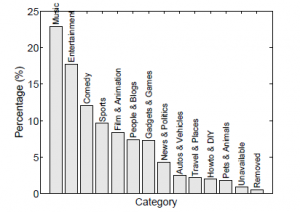Editors note: This post is regarding an earlier idea (GameX) which was later dismissed in favour of LeapIn.it (virtual world). However, this still offers some insight into how rich media is used within social networks and when MMOGs are considered as virtual worlds.
This post will outline academic work that has been done in the area of social networks specific to gaming. 80% of online social network users use social networks to strengthen their relationships with their friends, family members [2]. Some users create narratives of their everyday lives and post them in social network sites, sharing their experiences with others in creative ways [2]. This post will focus on how social networks encourage socialising and sharing content, in particular focusing on the usage of YouTube as a social network, followed by MMOGs.
YouTube
Since its inception as a video sharing website, YouTube has a social networking “layer” which has been attributed to its success [1]. This layer consists of interactions which encourage users to contribute to YouTube, including through providing the ability to comment on and rate videos, allowing users to subscribe to “channels”, and by providing video recommendations to users [1 and 3]. Further to this, YouTube (although this is not unique to YouTube) provides users with the ability to use videos to respond to other videos, giving users an alternative to text for discussion [7]. In 2009, 49.2% of videos in the Entertainment section of YouTube were video responses, of which 42% were posted within the first month of the original video [7], indicating a demand for such rich media in discussion. 17% were posted after three months, indicating that the demand for discussion may be long-term [7]. Finally, for content creators, YouTube rewards those who have videos which achieve a high number of views [1]. These rewards can take the form of awards or financial benefits, encouraging greater participation [1].
Despite the social network characteristics that YouTube presents, it has previously been shown that 58% of users have no connections to other users [1] (however, this may have since changed significantly). This study also identified that there exists networks of correlated videos, forming clusters based on the content. These findings suggest that the formation of these groups is an opportunity that can be exploited to build more powerful applications for social networking [1]. Moreover, 17.8% of the videos analysed in the study, which consisted of more than two million videos, are under Entertainment category, which contains videos related to sharing experiences with media, including games [Figure 1].
Other reasons behind the success of YouTube include is an easy to use interface for playing videos, and its provision of HTML tags that make it easy to embed, share and automatically post YouTube videos in other social networks and personal blogs [4].

MMOGs
Massively Multiplayer Online Games (MMOGs) incorporate elements of social networking in order to form part of the game play. World of Warcraft (WoW), for example, does so to encourage players to interact and collaborate with each other [11]. This has seen a great deal of success, with 240,000 users joining WoW in the first 24 hours of its release, and over 4 million joining in less that a year. This prompts a need for greater understanding of the effects of social networks within gaming.
One problem in trying to understand how MMOGs are used as social networks is the scale at which they are used – there are many forms of MMOGs, each offering different experiences to users [6]. Alexandru, Lăscăteu, and Ţăpuş (2010) attempted to gather data about such networks, and in doing so, were able to analyse behaviour of the more experienced players [6]. They identified that these players had a greater understanding of the game dynamics (for example, skill), and as such had greater ability at recognising in-game groups [6]. This in turn leads to voluntary collaboration motivated by social rewards [6]. Alexandru et al propose further analysis of social network occurrence within MMOGs such that they may be understood from a economic standpoint (for example, how advertising may be achieved through MMOGs) [6]. These findings have been largely reflected in a study of users of Second Life – a virtual world social network. The findings showed that 66% of users join to socialise and make new friends [11].
FarmVille, a game built on social networks, had 77 million player in 2010 with the player average age of 31 years old [9]. As a result, the gaming world is a big business that has been exploited by some game developers by providing players tools to create their own experiences and share them with their friends [9]. For example, FarmVille allows players to inform their friends and broadcast their successes in the game by providing links that can be shared in Online Social Networks and therefore motivating other users to join the game [10]. A study found that users of social games stay active and participate longer than in other social networks because they feel happy either because they taught other players who succeed in these games or because of “happy social embarrassment” feeling [10].
According to [10], online gaming communities have four types of players depending on their level of activity and social relationships and therefore a player can be a “community builder” are the active ones who have connections with many other players in the network and helps in building the online community, a “community member” has less gaming skills and less number of connections as they play with their friends, a “random player” can play with any other member in the community without preferring to play with specific partners and “faithful players” who play actively with at most two partners [10]. [10] argue that providing incentives to the users as well as having an effective pairing system are considered as building blocks for the success of online gaming communities [10].
[11] found that more than 53% of Thai youths play mobile games and suggest incorporating socializing features in mobile games for the purpose of having richer user experiences. They also argue that each game has a life cycle in which a player reaches the final phase as a result of a release of a new game to the market and this cycle can be extended by recommending the game to other users [11]. The competition, excitement and social interactions between members of online gaming communities are important factors that must be exploited by game designers to effectively target this market and therefore increasing the duration of this lifecycle [11]. It has been found that sharing gaming experiences between players is considered an important factor which motivates users to continuously play the game [11].
By interviewing game players in [11] to understand their gaming behaviours, some of them said that they share their best gaming experiences as videos in YouTube [11]. The competition between players and the pressure involved in trying to improve the player’s performance in the gaming world motivate the players to participate more and stay longer in the game [11]. This promotes the interaction between the players via e-mail, forums, discussion groups and posting videos in YouTube because of the lack of a social network with features that helps them to share their experiences [11].
Conclusion
The research conducted here will give insight into the design of our social network. I particular, we can give greater consideration into the social factors of social gaming, which both related to gaming as a field for social networks, and gamification design of social networks.
References:
[1] Cheng, Xu, Cameron Dale, and Jiangchuan Liu. “Understanding the characteristics of internet short video sharing: YouTube as a case study.” arXiv preprint arXiv:0707.3670 (2007).
[2] Subrahmanyam, Kaveri, et al. “Online and offline social networks: Use of social networking sites by emerging adults.” Journal of Applied Developmental Psychology 29.6 (2008): 420-433.
[3] Weaver, Alfred C., and Benjamin B. Morrison. “How Things Work-Social Networking.” Computer 41.2 (2008): 97.
[4] Cheng, Xu, Cameron Dale, and Jiangchuan Liu. “Statistics and social network of youtube videos.” Quality of Service, 2008. IWQoS 2008. 16th International Workshop on. IEEE, 2008.
[5] Cheng, Xu, Haitao Li, and Jiangchuan Liu. “Video sharing propagation in social networks: Measurement, modeling, and analysis.” INFOCOM, 2013 Proceedings IEEE. IEEE, 2013.
[6] Iosup, Alexandru, Adrian Lăscăteu, and Nicolae Ţăpuş. “Cameo: enabling social networks for massively multiplayer online games through continuous analytics and cloud computing.” Proceedings of the 9th Annual Workshop on Network and Systems Support for Games. IEEE Press, 2010.
[7] Benevenuto, Fabrício, et al. “Video interactions in online video social networks.” ACM Transactions on Multimedia Computing, Communications, and Applications (TOMCCAP) 5.4 (2009): 30.
[8] Lai, Linda SL, and Efraim Turban. “Groups formation and operations in the Web 2.0 environment and social networks.” Group Decision and Negotiation 17.5 (2008): 387-402.
[9] Kirman, Ben. “Emergence and playfulness in social games.” Proceedings of the 14th International Academic MindTrek Conference: Envisioning Future Media Environments. ACM, 2010.
[10] Balint, Mihaela, et al. “An analysis of social gaming networks in online and face to face bridge communities.” Proceedings of the third international workshop on Large-scale system and application performance. ACM, 2011.
[11] Paul, Sheila A., et al. “Socializing in mobile gaming.” Proceedings of the 3rd international conference on Digital Interactive Media in Entertainment and Arts. ACM, 2008.








Please comment with your real name using good manners.